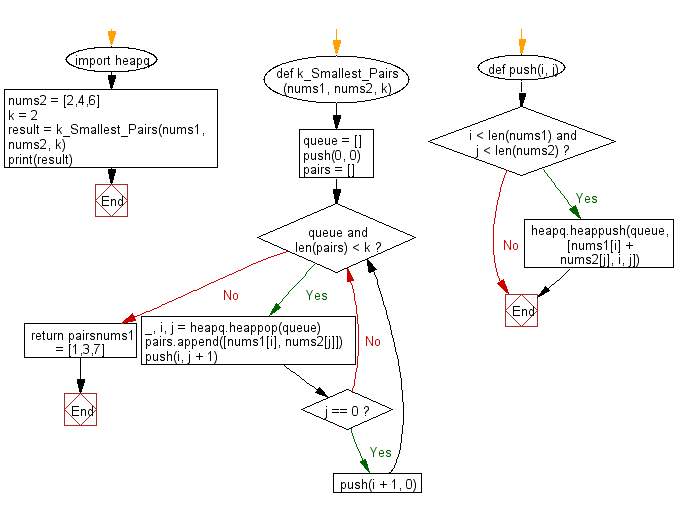Python: Find k number of pairs which consists of one element from the first array and one element from the second array
17. K Pairs from Two Sorted Arrays
You have two integer arrays sorted in ascending order and an integer k. Write a Python program to find k number of pairs (u, v) which consist of one element from the first array and one element from the second array using the heap queue algorithm.
Sample Solution:
Python Code:
import heapq
def k_Smallest_Pairs(nums1, nums2, k):
queue = []
def push(i, j):
if i < len(nums1) and j < len(nums2):
heapq.heappush(queue, [nums1[i] + nums2[j], i, j])
push(0, 0)
pairs = []
while queue and len(pairs) < k:
_, i, j = heapq.heappop(queue)
pairs.append([nums1[i], nums2[j]])
push(i, j + 1)
if j == 0:
push(i + 1, 0)
return pairs
nums1 = [1,3,7]
nums2 = [2,4,6]
k = 2
result = k_Smallest_Pairs(nums1, nums2, k)
print(result)
Sample Output:
[[1, 2], [1, 4]]
Flowchart:

For more Practice: Solve these Related Problems:
- Write a Python program to merge two sorted arrays into k pairs with the smallest sums using a min-heap and then print the resulting pairs.
- Write a Python script to generate k pairs (u, v) from two sorted arrays using heapq and then validate that these pairs have the smallest combined values.
- Write a Python program to implement a function that takes two sorted lists and an integer k, and returns the k pairs with the smallest sum using a heap.
- Write a Python function to use a min-heap to find the k smallest pairs from two arrays and then output the pairs along with their sum.
Go to:
Previous: Write a Python program which add integer numbers from the data stream to a heapq and compute the median of all elements.
Python Code Editor:
Have another way to solve this solution? Contribute your code (and comments) through Disqus.
What is the difficulty level of this exercise?
Test your Programming skills with w3resource's quiz.
